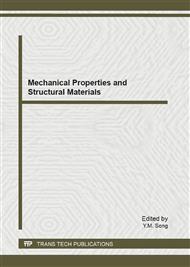[1]
Q. X. Yang, B. Liao, J. H. Liu, Effect of rare earth elements on austenite growth dynamics of steel 60CrMnMo, Journal of Rare Earths. 1998, 16(3): 274- 276.
Google Scholar
[2]
Y. Sahin, M. Erdogan , V. Kilicli, Wear behavior of austempered ductile irons with dual matrix structures, Mater. Sci. Eng. A 444 (2007) 31-38.
DOI: 10.1016/j.msea.2006.06.071
Google Scholar
[3]
A.S.M.A. Haseeb, Md. Aminul Islam, Md. Mohar Ali Bepari, Tribological behavior of quenched and tempered, and austempered ductile iron at the same hardness level, Wear. 244 (2000) 15-19.
DOI: 10.1016/s0043-1648(00)00404-x
Google Scholar
[4]
F. Iacoviello, O. DiBartolomeo, Damaging micromechanisms in ferritic–pearlitic ductile cast irons, Mater. Sci. Eng. A 478 (2008) 181-186.
DOI: 10.1016/j.msea.2007.05.110
Google Scholar
[5]
D. Dini, A. Sackfield, D. A. Hills, An axi-symmetric hertzian contact subject to cyclic shear and severe wear, Wear. 265 (2008) 1918-(1922).
DOI: 10.1016/j.wear.2008.04.031
Google Scholar
[6]
Yujin Fan, Xiaojing Yang, Zhekun Li, Micro contact process analysis in abrasive wear by finite element method, Chinese journal of mechanical engineering. 2005, 41(4): 35-37. (in Chinese).
DOI: 10.3901/jme.2005.04.035
Google Scholar
[7]
Liu Huixia, Yuan Chun jian, Si Hui, Wang Xiao, Fu Yonghong, Finite element analysis of the wear of regular micro texturing surface, Lubrication engineer. 2008, 33(2): 1-4 (in Chinese).
Google Scholar
[8]
H. Benabdallah, D. Olender, Finite Element Simulation of the Wear of Polyoxy methylene in pin-on-disc Configuration, Wear. 2006, 261(11): 1213-1224.
DOI: 10.1016/j.wear.2006.03.040
Google Scholar
[9]
U lf Sellgren, Stefan Björklund, Sören Andersson, A Finite Element-based Model of Normal Contact Between Rough Surfaces, Wear. 2003, 254(11): 1180-1188.
DOI: 10.1016/s0043-1648(03)00332-6
Google Scholar
[10]
P. L. Ko, S. S. Iyer, H. Vaughan, M. Gadala, Finite Element Modelling of Crack Growth and Wear Particle Formation in Sliding Contact, Wear. 2001, 251(9): 1265-1278.
DOI: 10.1016/s0043-1648(01)00780-3
Google Scholar
[11]
Priit Pödra, Sören Andersson, Simulating Sliding Wear with Finite Element Method, Tribology International. 1999, 32(2): 71-81.
DOI: 10.1016/s0301-679x(99)00012-2
Google Scholar
[12]
R. I. EI Soeudy. The Effect of Graphite Aspect Ratio on the Mechanical and Microstructural Properties of Cast Iron, Mat. -wiss. u. Werkstofftech. 2002(33): 73-79.
DOI: 10.1002/1521-4052(200202)33:2<73::aid-mawe73>3.0.co;2-d
Google Scholar
[13]
D. A. Sheng, H. Huang, J. Liu, Effects of rare earth alloys on structure sand properties of gray cast iron, Journal of the Less-Common Metals. 1989, 148: 85-89.
DOI: 10.1016/0022-5088(89)90014-3
Google Scholar
[14]
Yanyao Jiang, Huseyin Sehitoglu, Rolling contact stress analysis with the application of a new plasticity model, Wear. 191 (1996) 35-44.
DOI: 10.1016/0043-1648(95)06663-2
Google Scholar


